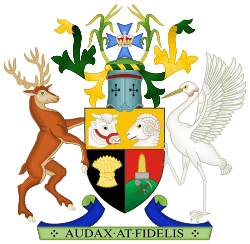Queensland Legislative Council
| Legislative Council | |
|---|---|
 | |
| Type | |
| Type | |
| History | |
| Established | 1 May 1860 |
| Disbanded | 23 March 1922 |
| Succeeded by | Unicameral Parliament of Queensland |
| Meeting place | |
|
Legislative Council Chamber Parliament House, Brisbane Queensland, Australia | |
The Queensland Legislative Council was the upper house of the parliament in the Australian state of Queensland. It was a fully nominated body which first took office on 1 May 1860. It was abolished by the Constitution Amendment Act 1921, which took effect on 23 March 1922.
Consequently, the Legislative Assembly of Queensland is the only unicameral state Parliament in Australia. Three territories, the Northern Territory, Australian Capital Territory and Norfolk Island, also maintain unicameral parliaments.
Most of the early members of the Council came from wealthy families, were well educated and were born in England.[1] Absenteeism was a problem in the early years, with some members returning to England, being absent for several years.[1]
Abolition
The Legislative Council was seen by the Australian Labor Party as undemocratic and a tool of patronage, and upon the establishment of a secure Labor majority in the Assembly in 1915, Labor sought the house's abolition. Bills for this purpose were rejected by the Council itself in 1915 and 1916, and a referendum failed on 5 May 1917 on a vote of 179,105 to 116,196. In 1920, the Government under Premier Ted Theodore changed tack, persuading the Governor of Queensland to appoint additional Labor members of the Council, thus securing a majority in that Chamber.
The abolition bill was eventually passed by the Assembly on a 51–15 vote on 24 October 1921. The bill was then introduced to the Council by the leader of the Government in the Council, Alfred James Jones, who remarked, "Until we had a majority here, [the Council] was obstructive, and now that we have a majority here it is useless." However, Opposition councillor Patrick Leahy protested that the abolition of the chamber would result in the Assembly being "able to do what it thinks fit" and becoming unaccountable. On 27 October 1921, the Council voted itself out of existence; the members who voted for the abolition were known as the "suicide squad". The Council rose for the last time at 8:37 p.m. that evening.
The non-Labor parties petitioned the British Government, but the Colonial Secretary, Winston Churchill, concluded that the matter was "essentially one for determination locally", and the Governor felt "unable to say that there is evidence of any strong or widespread feeling in the country against this assent being given." Royal Assent was given on 3 March 1922, and the Act was proclaimed in the Government Gazette 20 days later.
Labor's view was summed up in 1980 by Labor politician and historian Dr Denis Murphy, who claimed the "dominance of wealth and property over the Queensland parliament" was broken. However, some scholars and political commentators have argued that the excesses of the Bjelke-Petersen years (1968–1987) in Queensland were only possible because of the absence of a house of review, and that the problem was not the Council itself but its existence as a nominated rather than elected body (Legislative Councils in all other states were fully elective by 1900, except in New South Wales where some nominative features lasted until the 1970s.)
Several independents have at various times supported the reintroduction of an upper house.[2] The Queensland Greens support the reintroduction of an upper house elected by proportional representation.[3] Neither major party currently supports the reintroduction of an upper house.
Presidents of the Legislative Council
| Member | Party | Term in Office |
|---|---|---|
| Hon Sir Charles Nicholson | None | 22 May 1860 – 26 August 1860 |
| Hon Sir Maurice Charles O'Connell | None | 27 August 1860 – 23 March 1879 |
| Hon Sir Joshua Peter Bell | None | 3 April 1879 – 20 December 1881 |
| Hon Sir Arthur Hunter Palmer | None | 24 December 1881 – 20 March 1898 |
| Rt Hon Sir Hugh Muir Nelson | Ministerialist | 13 April 1898 – 1 January 1906 |
| Hon Sir Arthur Morgan | Ministerialist | 19 January 1906 – 19 December 1916 |
| Hon William Hamilton | Labor | 15 February 1917 – 17 August 1920 |
| Hon William Lennon | Labor | 18 August 1920 – 23 March 1922 |
See also
- Members of the Queensland Legislative Council by year
- Category:Members of the Queensland Legislative Council by name
References
- 1 2 Armstrong, Lyn (1997), "'A somewhat rash experiment':Queensland Parliament as a microcosm of society", in Shaw, Barry, Brisbane:Corridors of Power, Papers, 15, Brisbane: Brisbane History Group Inc, pp. 54–55, ISBN 0-9586469-1-0
- ↑ Amy Remeikis (23 November 2013). Queensland needs an upper house: independent MPs. The Brisbane Times. Fairfax Media. Retrieved 31 January 2015.
- ↑ Democracy Archived August 8, 2014, at the Wayback Machine.. Queensland Greens. Retrieved 31 January 2015.
External links
| Wikimedia Commons has media related to Parliament of Queensland. |
- Constitution Act Amendment Act of 1921
- Factsheet - Abolition of the Legislative Council (Queensland Parliament)
- Aroney, Nicholas; Prasser, Scott (February 2007). "An upper house for Queensland: an idea whose time has come" (PDF). Democratic Audit of Australia (ANU). Retrieved 25 April 2009.